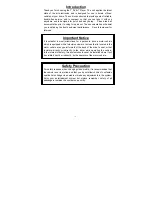
135
the offset is 0 volts).
z
The maximum amplitude will be limited if the data points do not span
the full range of the output DAC (Digital-to-Analog converter). For
example, the built-in sinc wave does not use the full range of binary
values between ±8191 and thus its maximum amplitude is limited to
6.087 Vpp (into 50
Ω
).
z
The
DATA:DAC
command overwrites the previous waveform in the
volatile memory (and no error will be generated). Use the
DATA:COPY
command to copy the waveform to non-volatile memory.
DATA:CATalog?
List all waveform names available for use. The names of the five built-in
waveforms (in non-volatile memory) and all user-defined waveforms (in volatile
memory) will be returned. “Volatile” will be returned when a built-in waveform is
currently downloaded to volatile memory. To remove a waveform from volatile
memory or any use-defined waveforms in non-volatile memory, use DATA:DEL
command.
DATA:NVOLatile:CATalog?
List the names of all user-defined arbitrary waveforms downloaded to
non-volatile memory. Up to four waveform names will be returned. If there is no
waveform currently downloaded, a null string “” will be returned. To remove any
use-defined waveforms in non-volatile memory, use DATA:DEL command.
DATA:NVOLatile:FREE?
Query the number of available slots for storing the user-defined waveforms.
DATA:DELete <arb name>
Remove the specific arbitrary waveform from memory. It can be the waveforms
in volatile memory or the user-defined waveforms in non-volatile memory. You
cannot delete an arbitrary waveform that is currently output, or an error will be
generated.
DATA:DELete:ALL
Remove all user-defined waveforms from memory. All waveforms in volatile
memory and user-defined waveforms in non-volatile memory will be deleted,
but the built-in waveforms in non-volatile memory will not be deleted. You
















































